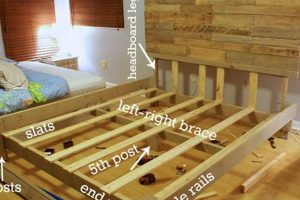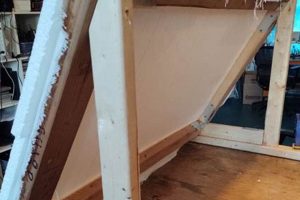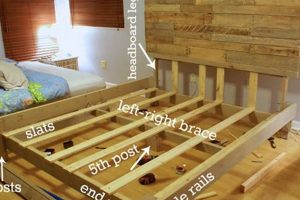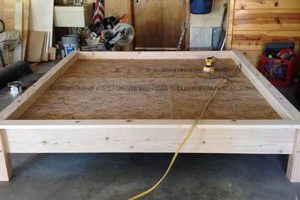A do-it-yourself sleeping platform, constructed close to the ground, represents a minimalist approach to bedroom furnishing. Typically assembled from lumber or repurposed materials, this style of bed eliminates the need for a conventional box spring and often features a simple, low-profile design. Examples include platforms built from reclaimed wood pallets, interconnected wooden slats, or stacked timber frames.
Choosing this type of bed offers several advantages, including cost savings and design flexibility. Construction uses readily available materials and basic tools. The low height can create a more open and spacious feel within a room. Furthermore, this style aligns with minimalist and Scandinavian design aesthetics, promoting a sense of simplicity and grounding within the sleeping environment. Historically, floor-level sleeping arrangements have roots in various cultures, reflecting a connection to nature and a preference for understated living.
The following sections will delve into specific construction techniques, material selection considerations, and design adaptations relevant to creating a personalized sleeping space. Exploration will also include safety guidelines and considerations for mattress compatibility.
Construction Guidance
The creation of a sleeping platform requires careful planning and execution to ensure structural integrity and safety. The following tips provide guidance on key considerations during the construction process.
Tip 1: Material Selection. Choose lumber appropriate for the intended load. Softwoods, such as pine, are cost-effective but may require thicker dimensions than hardwoods, like oak or maple, to achieve adequate support. Ensure lumber is kiln-dried to minimize warping after assembly.
Tip 2: Precise Measurements. Accurate measurements are essential for a stable and properly sized platform. Measure the intended mattress dimensions precisely and add a small allowance (approximately 1 inch on each side) to prevent overhang or squeezing.
Tip 3: Secure Joinery. Employ robust joinery techniques, such as mortise and tenon, dowel joints, or metal fasteners, to ensure the frame’s stability. Wood glue should be used in conjunction with mechanical fasteners for enhanced strength.
Tip 4: Adequate Support. Provide sufficient support, particularly for larger mattress sizes. This can be achieved by adding central support beams or strategically placed legs to prevent sagging. The spacing of supports should be determined based on the lumber’s span rating.
Tip 5: Surface Finishing. Sand all surfaces thoroughly to eliminate splinters and sharp edges. Apply a non-toxic sealant or finish to protect the wood from moisture and wear. Consider using a low-VOC (volatile organic compound) finish to minimize off-gassing.
Tip 6: Ventilation Considerations. If the mattress is placed directly on the platform, ensure adequate ventilation to prevent moisture buildup and mold growth. This can be achieved through the use of spaced slats or a breathable underlayment.
Tip 7: Safety Checks. Prior to use, thoroughly inspect the structure for any loose connections or potential hazards. Ensure all fasteners are securely tightened and that the platform is stable on the floor.
Adherence to these guidelines will contribute to the creation of a functional and durable sleeping platform, maximizing its lifespan and ensuring user safety.
The subsequent section will address design variations and aesthetic considerations applicable to the project.
1. Material Durability
Material durability is a paramount consideration in the construction of a sleeping platform. The selection of appropriate materials directly influences the lifespan, structural integrity, and long-term cost-effectiveness of the bed frame. The ability of the chosen material to withstand constant use and resist degradation is crucial for a safe and sustainable structure.
- Wood Species and Resistance to Decay
The type of wood significantly affects resistance to decay, insect infestation, and general wear. Hardwoods, such as oak or maple, generally exhibit greater density and inherent resistance compared to softwoods like pine or fir. Proper treatment and sealing can improve the durability of softer woods, but inherent differences in material properties remain a key factor. Utilizing naturally rot-resistant woods like cedar, even if more expensive, can eliminate the need for chemical treatments and extend service life.
- Resistance to Moisture and Warping
Exposure to moisture can compromise the structural integrity of the bed frame, leading to warping, swelling, and the development of mold or mildew. Wood’s moisture content must be carefully controlled, and the chosen material should exhibit resistance to moisture absorption. Kiln-dried lumber is preferable, and the application of water-resistant finishes, such as polyurethane or varnish, provides an additional layer of protection. The design should also promote airflow to minimize moisture accumulation.
- Load-Bearing Capacity and Structural Strength
The material must possess adequate load-bearing capacity to support the combined weight of the mattress and occupants without deformation or failure. The selection of lumber dimensions and the design of the frame’s support structure must account for this load. Using materials with a higher modulus of elasticity and bending strength can allow for thinner profiles while maintaining structural integrity. For example, metal supports or reinforced corners may be added to increase the load-bearing capacity of a wood frame.
- Resistance to Scratches and Wear
The surface of the sleeping platform is subject to daily wear and tear, including scratches, abrasions, and impacts. Choosing materials with a durable surface finish and inherent resistance to scratching can maintain the bed frame’s aesthetic appeal over time. Hardwood surfaces are more resistant to scratching than softwood, and durable finishes like polyurethane or epoxy resin can provide added protection. Regular cleaning and maintenance can also help to minimize surface damage.
These multifaceted considerations underscore the importance of selecting materials carefully for a DIY sleeping platform. A thorough understanding of material properties and their implications for durability is essential for creating a stable, safe, and long-lasting sleeping solution.
2. Structural Integrity
Structural integrity represents a crucial aspect of a do-it-yourself sleeping platform. The platform’s ability to safely support the weight of a mattress and its occupants depends directly on the soundness of its construction. A poorly designed or executed structure can lead to instability, failure, and potential injury. Therefore, careful consideration must be given to factors influencing structural strength.
- Joint Strength and Stability
The connections between individual components of the platform are vital for maintaining overall structural integrity. Weak or improperly executed joints can become points of failure under stress. Techniques such as mortise and tenon, dovetail joints, or the use of metal fasteners, combined with appropriate adhesives, provide robust connections. The choice of joint depends on the skill of the builder, available tools, and the aesthetic goals of the project. A joint’s ability to resist racking forces, or lateral movement, is particularly important for platform stability.
- Load Distribution and Support Spacing
The frame must distribute the weight of the mattress and occupants evenly across its structure to prevent localized stress concentrations. Adequate support spacing is essential, with closer spacing required for thinner or weaker materials. Central support beams or strategically placed legs can reinforce larger platforms and prevent sagging. The placement of these supports must align with the frame’s overall design and the anticipated load distribution.
- Material Selection and Dimensional Stability
The choice of materials directly affects the platform’s load-bearing capacity and resistance to deformation. Hardwoods, such as oak or maple, offer greater strength and stiffness compared to softwoods like pine or fir. The dimensions of the lumber used in construction must be sufficient to withstand the applied loads. Dimensional stability, the ability of the material to resist changes in shape or size due to environmental factors, is also crucial for long-term structural integrity. Kiln-dried lumber is preferred to minimize warping or shrinkage.
- Floor Contact and Stability
The interface between the platform and the floor surface influences overall stability. An uneven or unstable floor can compromise the structural integrity of the frame. Leveling the platform using adjustable feet or shims ensures even weight distribution and prevents rocking or movement. The material used for the feet should be durable and non-marring to protect the floor surface. Consideration should be given to the floor’s load-bearing capacity, particularly for heavier platforms or in older buildings.
These facets highlight the interdependent factors contributing to structural integrity in the context of a sleeping platform. Attention to joint construction, load distribution, material selection, and floor contact is essential for creating a safe, stable, and durable sleeping surface.
3. Ventilation Design
Proper ventilation is a critical, though often overlooked, aspect of the floor-level sleeping platform. The close proximity of the mattress to the floor creates an environment susceptible to moisture accumulation. The human body releases moisture during sleep, which can become trapped between the mattress and the floor, potentially fostering mold and mildew growth. This, in turn, can lead to health issues, including allergies and respiratory problems. Effective ventilation design aims to mitigate these risks by promoting airflow and allowing moisture to dissipate. A sleeping platform lacking adequate ventilation functions as a moisture trap, accelerating mattress degradation and potentially jeopardizing the sleeper’s well-being. The design becomes a significant determinant of hygiene and longevity.
Practical implementation of ventilation design can take several forms. The most common approach involves constructing the platform with spaced slats rather than a solid surface. The gaps between the slats allow air to circulate beneath the mattress, preventing moisture buildup. Another strategy incorporates the use of breathable underlayment materials between the mattress and the platform surface. These materials, often made of natural fibers or synthetic mesh, facilitate airflow while providing a barrier against dust and debris. Examples can be seen in various online tutorials and commercially available platform bed designs, where spacing and materials are deliberately selected to address ventilation concerns. Failure to include such considerations can result in tangible negative outcomes, such as visible mold formation on the underside of a mattress, necessitating costly replacements.
In summary, the ventilation design is not merely an aesthetic consideration but a fundamental requirement for a healthy and durable floor-level sleeping platform. Neglecting this aspect introduces potential health risks and reduces the lifespan of the mattress. While various methods can achieve adequate ventilation, the underlying principle remains constant: facilitating airflow to prevent moisture accumulation. Successfully integrating ventilation design into the sleeping platform construction contributes to a more hygienic and comfortable sleeping environment.
4. Safety Compliance
Adherence to safety standards is paramount in the construction of a do-it-yourself sleeping platform. The absence of established manufacturing regulations for such projects necessitates a proactive approach to ensure user safety and prevent potential hazards. A structurally unsound or improperly finished platform poses risks ranging from minor injuries to more severe incidents. Therefore, thorough consideration of safety protocols is integral to the design and construction process.
- Material Selection and Toxicity
The selection of appropriate materials is crucial to minimizing exposure to hazardous substances. Untreated lumber may contain chemical residues from processing, while some paints and finishes emit volatile organic compounds (VOCs) that can negatively impact air quality. Opting for sustainably sourced, low-VOC materials reduces these risks. Using reclaimed wood requires careful inspection to ensure it is free from lead paint or other contaminants. Furthermore, consideration should be given to fire resistance, particularly when selecting materials for mattresses and bedding.
- Structural Stability and Load Capacity
Ensuring the platform can safely support the weight of the mattress and its occupants is fundamental. Overestimation of the platform’s load capacity can lead to structural failure, resulting in potential injury. Proper joinery techniques, adequate support spacing, and the use of materials with sufficient strength are essential. Testing the platform’s stability before regular use is advisable, particularly for larger or more complex designs. Building codes for conventional bed frames may provide useful benchmarks for assessing structural soundness.
- Surface Finishing and Edge Treatment
Sharp edges and rough surfaces pose a risk of cuts and abrasions. Thorough sanding and the application of a smooth, durable finish are necessary to mitigate these hazards. Rounded edges or the use of edge banding can further reduce the risk of injury. The finish should be non-toxic and resistant to chipping or peeling, as loose particles can be ingested. Regular inspection and maintenance are necessary to identify and address any damage to the surface finish.
- Accessibility and Emergency Egress
In rooms with limited space, a floor-level sleeping platform may obstruct pathways or impede emergency egress. The platform should be positioned to allow for clear access to doorways and windows. Consideration should be given to the mobility limitations of potential users, such as elderly individuals or those with disabilities. Fire safety plans should account for the presence of the platform and ensure that occupants can safely evacuate the room in the event of an emergency.
Addressing these factors related to safety compliance is indispensable for responsible construction. While a do-it-yourself approach offers customization and cost savings, it also necessitates a heightened awareness of potential hazards and a commitment to implementing appropriate safety measures. A meticulously planned and executed design minimizes risks and provides a secure sleeping environment.
5. Size Accuracy
In the context of constructing a do-it-yourself sleeping platform, precise dimensional accuracy is not merely desirable; it is a fundamental requirement for both functionality and aesthetics. Deviations from intended measurements can compromise structural stability, diminish the platform’s visual appeal, and ultimately render the sleeping space unusable. The relationship between the platform and the intended mattress necessitates careful attention to detail during the planning and execution phases.
- Mattress Compatibility and Fit
The primary function of a sleeping platform is to support a mattress securely. Inaccurate dimensions can result in a mattress that either overhangs the platform edges, creating a tripping hazard and detracting from the visual aesthetic, or a mattress that is too small, leaving unsightly gaps and potentially shifting during use. Precise measurements of the mattress’s length, width, and thickness are essential for determining the platform’s internal dimensions. An allowance of approximately one inch on each side is often recommended to facilitate easy placement and removal of bedding while maintaining a snug fit. Standard mattress sizes (twin, full, queen, king) provide a useful starting point, but individual mattress dimensions should be verified, as slight variations can occur between manufacturers.
- Structural Integrity and Load Distribution
Dimensional accuracy directly impacts the platform’s structural integrity. If the frame is not square or if the support beams are unevenly spaced, the weight of the mattress and occupants will not be distributed evenly, leading to stress concentrations and potential failure points. Precise measurements are crucial for ensuring that all components of the frame are properly aligned and securely joined. Accurate cutting and assembly techniques minimize the risk of warping, sagging, or instability over time. The use of a framing square and level during construction is essential for maintaining dimensional accuracy and ensuring a stable foundation.
- Aesthetic Harmony and Visual Appeal
Dimensional accuracy contributes significantly to the overall visual appeal of the sleeping platform. A precisely constructed frame with clean lines and accurate proportions enhances the aesthetic of the room and creates a sense of order and balance. Conversely, a poorly measured or assembled frame can appear visually disjointed and detract from the room’s overall design. Accurate measurements are particularly important for designs that incorporate decorative elements or intricate joinery. Small errors in dimension can become magnified as the project progresses, leading to a final product that does not meet aesthetic expectations.
- Material Utilization and Cost Efficiency
Inaccurate measurements can lead to inefficient material utilization and increased project costs. Overestimating material requirements can result in wasted resources, while underestimating can necessitate additional purchases and delays. Precise measurements minimize the risk of cutting errors and allow for optimal material nesting, reducing waste. Careful planning and accurate measurement techniques contribute to a more cost-effective and sustainable construction process. Furthermore, dimensional accuracy reduces the likelihood of having to rework components or rebuild sections of the frame, saving both time and materials.
These aspects demonstrate that accurate sizing is not merely a procedural detail but a core element that influences various facets of the project. Diligence in measuring and cutting yields a sleeping platform that is not only functional and safe but also aesthetically pleasing and economically sound. Consequently, meticulous attention to dimensioning is a hallmark of a well-executed do-it-yourself endeavor.
6. Aesthetic Integration
Aesthetic integration, in the context of a do-it-yourself sleeping platform, denotes the seamless incorporation of the bed frame’s design into the existing or intended aesthetic of the bedroom. This consideration extends beyond mere visual appeal, encompassing the harmonious blending of form, materials, and spatial arrangement to create a cohesive and balanced environment. A successful integration elevates the platform from a functional object to an integral element of the room’s overall design narrative.
- Material Selection and Consistency
The choice of materials significantly influences aesthetic integration. The selected wood species, finishes, and hardware should complement the existing color palette, textures, and styles of the room. For example, a bedroom featuring a minimalist, Scandinavian aesthetic might benefit from a platform constructed from light-toned wood with a natural finish and clean, simple lines. Conversely, a room with a rustic or industrial theme could incorporate reclaimed wood with exposed fasteners and a darker, more textured finish. Consistency in material choice ensures a unified and visually appealing design.
- Height and Proportionality
The low profile of the sleeping platform inherently contributes to a minimalist aesthetic and can enhance the perceived spaciousness of a room. However, the height of the platform must be carefully considered in relation to the dimensions of the room and the height of other furniture. A platform that is disproportionately low or high can disrupt the visual balance of the space. Maintaining proportional harmony ensures that the platform integrates seamlessly into the room’s existing layout.
- Spatial Arrangement and Flow
The placement of the sleeping platform within the room should promote a sense of spatial flow and ease of movement. The platform should not obstruct pathways or create visual clutter. Consider the relationship between the platform and other key elements of the room, such as windows, doors, and focal points. Orienting the platform to maximize natural light and views can enhance the room’s overall aesthetic appeal. Careful spatial planning contributes to a harmonious and functional living space.
- Integration with Bedding and Accessories
The selection of bedding, pillows, and other accessories plays a crucial role in aesthetic integration. The colors, patterns, and textures of the bedding should complement the platform’s design and the overall aesthetic of the room. Minimalist bedding with neutral tones and clean lines is often a suitable choice for a sleeping platform. Incorporating natural textures, such as linen or cotton, can enhance the room’s organic feel. Careful selection of accessories contributes to a cohesive and visually appealing bedroom environment.
These aspects illustrate the multifaceted nature of aesthetic integration in the context of a DIY sleeping platform. By carefully considering materials, height, spatial arrangement, and the interplay with bedding and accessories, the platform can be transformed from a mere piece of furniture into an integral element of a well-designed and harmonious bedroom.
7. Cost-Effectiveness
The appeal of constructing a sleeping platform lies significantly in its potential for cost reduction compared to purchasing a conventional bed frame. This cost-effectiveness stems from several factors, including the elimination of manufacturing markups, the use of readily available and often less expensive materials, and the reduction of shipping costs associated with pre-assembled furniture. The direct purchase of lumber or the repurposing of materials, such as reclaimed wood, can substantially decrease the overall expenditure. Furthermore, the simplified design of many sleeping platforms translates to reduced labor costs, as the construction process typically requires basic tools and minimal expertise.
However, cost-effectiveness does not equate to a disregard for quality or safety. While less expensive materials may initially seem attractive, their long-term performance must be carefully considered. For instance, opting for untreated softwood may lead to premature degradation and the need for repairs or replacement, ultimately negating initial savings. Similarly, neglecting proper joinery techniques or structural support can compromise the platform’s stability, posing a safety risk. A balanced approach involves selecting affordable materials that meet structural requirements and employing construction methods that ensure durability.
In summary, cost-effectiveness represents a central advantage of the do-it-yourself sleeping platform, but its pursuit should be tempered by a commitment to quality, safety, and long-term value. A well-planned project prioritizes durable materials, sound construction practices, and a clear understanding of the intended use, resulting in a cost-effective and reliable sleeping solution. The potential for savings can be maximized through careful planning and resourcefulness, but compromising on structural integrity or safety undermines the overall benefit.
Frequently Asked Questions Regarding Sleeping Platforms
The following addresses common inquiries concerning the construction and use of sleeping platforms, providing concise and authoritative responses.
Question 1: Is a slatted platform necessary for all mattresses?
A slatted platform promotes air circulation and minimizes moisture accumulation, particularly beneficial for memory foam and hybrid mattresses. Mattresses with enhanced breathability may be compatible with solid platforms, but careful monitoring for moisture buildup is advisable.
Question 2: What is the recommended height for a platform?
Optimal height depends on user preference and physical considerations. A height of 8-12 inches facilitates easy access while maintaining a low profile. Individuals with mobility limitations may require a higher platform for ease of ingress and egress.
Question 3: Can any type of wood be used for platform construction?
While various wood types are suitable, hardwoods (e.g., oak, maple) offer superior strength and durability compared to softwoods (e.g., pine, fir). Kiln-dried lumber minimizes warping and cracking. Treated lumber is recommended for outdoor applications to prevent rot and insect infestation.
Question 4: What are the essential safety considerations?
Key safety measures include ensuring structural stability, eliminating sharp edges or protrusions, and using non-toxic finishes. The platform should be capable of supporting the combined weight of the mattress and occupants. Regular inspection for loose connections or damage is recommended.
Question 5: How can squeaking be prevented?
Squeaking often results from friction between wooden components. Lubricating joints with wax or applying felt pads between contact points can mitigate this issue. Ensuring that all fasteners are securely tightened is also essential.
Question 6: What is the best method for attaching the platform to the floor?
Direct attachment to the floor is generally unnecessary and can impede relocation. Adjustable feet or shims can be used to level the platform on uneven surfaces. For enhanced stability on smooth floors, consider using non-slip pads beneath the platform legs.
These responses offer concise guidance on key aspects of sleeping platform design and construction. Prioritizing structural integrity, material selection, and safety protocols is crucial for creating a functional and long-lasting sleeping solution.
The following section will address common design modifications.
Conclusion
This exploration of the diy floor bed frame has underscored critical considerations encompassing material selection, structural integrity, ventilation, safety, dimensional accuracy, aesthetic harmony, and cost-effectiveness. These elements collectively determine the success and longevity of such a project. A comprehensive understanding and meticulous application of these principles are crucial for achieving a functional and aesthetically pleasing outcome.
Constructing a sleeping platform represents a commitment to both resourcefulness and mindful living. The information presented serves as a foundation for informed decision-making, promoting responsible construction practices and ensuring a secure, comfortable, and personalized sleeping environment. Further research and careful planning are strongly encouraged prior to undertaking such an endeavor.







